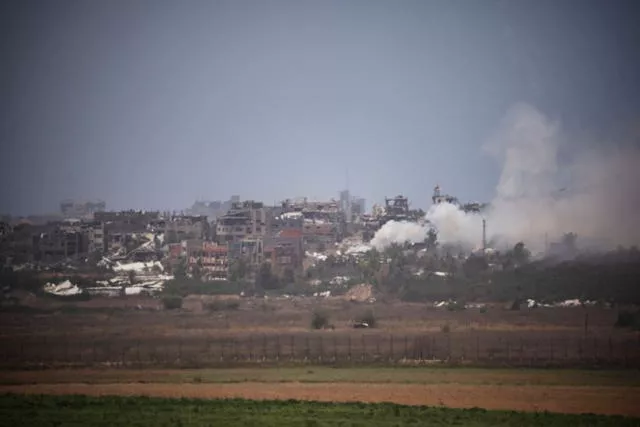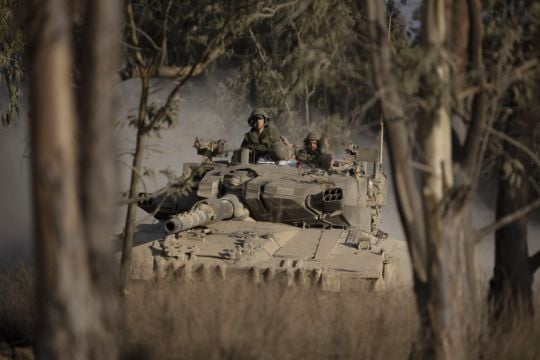Humanitarian workers have started moving tonnes of aid that had been piled up at a US-built pier off the Gaza coast to warehouses in the besieged territory, the United Nations said.
The move is an important step as the US considers whether to resume pier operations after yet another pause due to heavy seas.
It was not clear when the aid might reach Palestinians in Gaza, where experts have warned of the high risk of famine as the war between Israel and Hamas militants is in its ninth month.
This is the first time trucks have moved aid from the pier since the UN’s World Food Programme (WFP) suspended operations there due to security concerns on June 9.

Millions of pounds of aid have piled up. In just the last week, more than 10 million pounds were moved ashore, according to the US military.
A WFP spokesperson, Abeer Etefa, told The Associated Press this is a one-time operation until the beach is cleared of the aid and is being done to avoid spoilage. Further UN operations at the pier depend on UN security assessments, Ms Etefa added.
The UN is investigating whether the pier was used in an Israeli military operation last month to rescue three hostages.
If WFP trucks successfully bring the aid to warehouses inside Gaza, that could affect the US military’s decision whether to reinstall the pier, which was removed due to weather Friday. American officials said they were considering not reinstalling the pier because of the possibility that the aid would not be picked up.
"Trash is piling up everywhere, people are living under plastic sheeting where temperatures soar.” @UNWateridge
Families in #Gaza live next to mountains of garbage and sewage. With very few bathrooms available and unbearable summer heat, the sanitary conditions are desperate. pic.twitter.com/V8Q0H7Np7P— UNRWA (@UNRWA) June 29, 2024
Even if the UN decides to keep transporting aid from the pier into Gaza, lawlessness around humanitarian convoys will be a further challenge to distribution.
The convoys have come under attack in Gaza. While most aid deliveries come by land, restrictions around border crossings and on what items can enter Gaza have further hurt a population that was already dependent on humanitarian aid before the war.
The June 9 pause at the pier came after the Israeli military used a nearby area to fly out hostages after their rescue in a raid that killed more than 270 Palestinians, prompting a UN review over concerns that aid workers’ safety and neutrality may have been compromised.
Meanwhile, a senior Biden administration official said the US has presented new language to intermediaries Egypt and Qatar aimed at trying to jump-start the stalled Israel-Hamas negotiations.

The official said the revised text focuses on negotiations that are to start between Israel and Hamas during the first phase of a three-phase deal that US President Joe Biden laid out nearly a month ago.
The first phase calls for a “full and complete ceasefire”, a withdrawal of Israeli forces from all densely populated areas of Gaza and the release of a number of hostages, including women, the elderly and the wounded, in exchange for the release of hundreds of Palestinian prisoners.
The proposal called for the parties to negotiate the terms of the second phase during the 42 days of phase one.
Under the current proposal, Hamas could release all the remaining men, both civilians and soldiers. In return, Israel could free an agreed-upon number of Palestinian prisoners and detainees. The releases will not occur until “sustainable calm” takes effect and all Israeli troops withdraw from Gaza.
We welcome yesterday’s evacuation of 21 patients outside of #Gaza. This is the first since the Rafah crossing closure on 7 May.
Over 10,000 patients still need medical evacuations.
We appeal for facilitated medical evacuation via all possible routes, including Rafah and Karem… pic.twitter.com/A2o1zFD7UO— Tedros Adhanom Ghebreyesus (@DrTedros) June 28, 2024
The new proposed language, which the official did not detail, aims to find a solution to differences between Israel and Hamas about the parameters of the negotiations between phase one and phase two.
Hamas wants those negotiations centred on the number and identity of Palestinian prisoners who will be released from Israeli jails in exchange for remaining living Israeli soldiers and male hostages held in Gaza, the official said.
Israel wants the negotiations to be much broader and include the demilitarisation of the territory controlled by Hamas.
More than 37,800 Palestinians have been killed in the war since it began with Hamas’ attack on southern Israel on October 7, according to Gaza’s health ministry, which does not distinguish between civilians and combatants in its toll.
The ministry said the bodies of 40 people killed by Israeli strikes had been brought to local hospitals over the past 24 hours.
➡️ The @theipcinfo report on #Gaza shows a slight improvement in hunger levels thanks to increased food deliveries and nutrition services.
To reduce the risk of famine, we need sustained humanitarian access across the Strip, for food, nutrition, clean water, and health care.— World Food Programme (@WFP) June 26, 2024
At least two people were killed and six injured, including a child, in a strike in Bureij camp in central Gaza.
The October 7 Hamas attack killed some 1,200 people, mostly civilians, and another 250 people were taken hostage.
Israeli forces have been battling Palestinian militants in an eastern part of Gaza City over the last week. Tens of thousands of Palestinians have fled their homes, according to the UN.
The Israeli military acknowledged an operation against Hamas fighters in Shijaiyah and on Saturday noted “close-quarters combat”.







